
Nuclear Emergency Information
(A Few Tips For Survival)
by
Kraig J. Rice
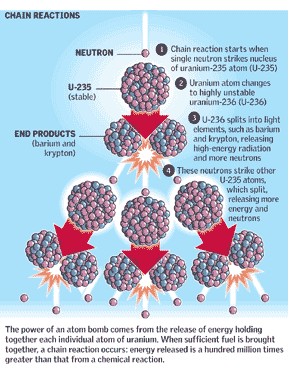
TABLE OF CONTENTS
(clicking on these links will move you down the page)

Nuclear Emergency Information
(A Few Tips For Survival)
by
Kraig J. Rice

TABLE OF CONTENTS
(clicking on these links will move you down the page)
INTRODUCTION
The Atomic Bomb Attack (and what to do)
The Dirty Bomb Attack (and what to do)
A Few Frequently Asked Questions
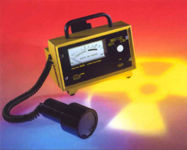
I believe that Jesus Christ wants His followers to be informed and prepared on how to physically survive an atomic bomb attack. Let's briefly examine a nuclear explosion. There is a lot of talk these days about how to survive such an attack. There are two main different types of nuclear weapons that one needs to know about-
the atomic bomb type and
the RDD dirty bomb type.
Let's take a look at each one.

What is this bomb?
In basic terms a conventional bomb, artillery shell, mortar shell, or hand grenade uses explosive material encased in steel. When the explosive goes off it breaks up it's steel container and propels those steel pieces through the air in the hopes of hitting soft human flesh to cause injury and death. The explosion itself puts out a shock wave called a concussion wave that is dangerous and can be fatal. A person's eyes and ear drums can be damaged just by the concussion. A person's distance away from a conventional weapon when it explodes is crucial to their survival. So keeping all of this in mind, let's take a look at a basic nuclear bomb.
Instead of using an explosive powder inside of a steel casing like a conventional bomb, this bomb consists of one of earth's elements that can be manipulated to blow apart. This element is uranium. It's a radioactive material. It can be blown apart by fission (of uranium) in the atomic bomb or by fusion (of hydrogen) in the hydrogen bomb.
A small atomic bomb is the equivalent of 20,000 tons of TNT. TNT is the explosive powder manufacturers use to make dynamite from. An English ton is 2,000 pounds of weight. 20,000 times 2,000 gives us a total of 40,000,000 pounds. So, in one bomb there is the equivalent of 40,000,000 pounds of weight of dynamite powder ready to explode all at once. The weapon is only about the size of a basketball but it makes a big mess after it explodes. It is properly titled a weapon of mass destruction (WMD).

What does this bomb do?
The first thing that happens is that it explodes. There is a tremendous blast. The shock wave blast area is well over twenty three miles (46 kilometers) from where the bomb explodes in every direction. There is a temporary flash of light equal to about 100 or so of our earth's suns. Don't look at this light from a distance with your naked eyes or with just sun glasses on lest you go blind. There is an immediate fire ball going out in all directions directly around the bomb for approximately one half mile (1 kilometer). This is called "ground zero" by scientists. If you are in this half mile area your body will die from the intense heat.
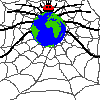
Satan wants to cast his web of
world domination
by the use of nuclear warfareThis shock wave travels at the speed of sound or at 1050 feet per second so it is very fast. Past a half mile the shock wave keeps going- like a tital wave of hot air pressure. There will be heavy structural damage up to 7 miles out from where the bomb was detonated. There will be moderate damage from 7-11 miles out. There will be light damage 11-23 miles out.
The purpose of the heat and air blast is to inflict civilian casualties and destroy enemy buildings. At this stage it is not too dissimilar to the use of napalm, phosphorus, or other incindiary (conventional) bombs dropped on civilian cities during World War Two.
If you are out in the open, yet close enough to actually see the explosion itself, but farther than 1/2 mile away, your first thought of survival action should be to duck and cover. Get in your fox hole if you are a soldier on the front lines. If you are a civilian you should find some place low and take cover. Let the air blast pass over the top of you. Let flying debris pass over the top of you. The shock wave is very powerful and can be very dangerous. Once this wave passes the next thing to happen are fires springing up in the wake of the wreckage. Burnable objects will have been set on fire after the heat wave ignited them.
The next thing that happens is a mushroom cloud of dust, water vapor, and smoke going high into the sky. When a nuclear weapon explodes near the ground, great quantities of pulverized earth and other debris are sucked up into the nuclear cloud. Small particles of radiation will attach itself to these dust, vapor, and smoke particles. One rule of thumb is that if there is not enough fallout that you can see, then there is not enough of it that it will kill you. Fallout is usually small grain dust or grit, often having a light color, but not always. It depends upon its source. The best place to spot it is on a smooth surface, like the hood of a car. When these radioactive particles come back to earth it is called nuclear fallout. This radiation is designed to kill those local people who are not killed from the heat, shock wave, or from falling buildings, flying debris, or fire in the rubble.
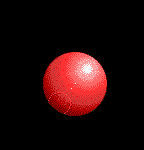
How Do I Avoid Any Radiation?
Most of the radiation is given off locally and quickly- therefore, the first few hours after an attack is the most dangerous period. The particles themselves look like grains of salt or sand, but stay away from these as the rays are invisible. Don't let your children play outside in this stuff. Areas close to the nuclear explosion might receive fallout within 15 to 30 minutes. Generally, the fallout pattern after 36 hours from the detonation of a single 15-megaton thermonuclear bomb is 20 miles (40 kilometers) upwind and over 320 miles (640 kilometers) downwind from where the bomb exploded.
The wind carries the radioactive materials through the air. This means that very large areas will become contaminated and you will need to plan for this if you are at least 320 miles downwind from the explosion. You will need to find shelter and stay away from the bombed area for a long period of time depending on the extent and severity of the contamination. If you live within 320 miles down wind of the explosion then you may need to travel a minimum of 50 miles (100 kilometers) in a horizontal (side ways) direction (from the major direction of the wind) in order to escape from this zone. If you stay in this area or zone then you will need to take appropriate shelter from the radiation for a 14 day period of time. If you stay and you do not take appropriate shelter then you may get radiation sickness. I deal with radiation sickness in greater detail farther down this page.
If you live or work outside of this area or zone you can thank God that you were spared and try to do what you can to help others who were not so fortunate. Overhead utility lines may have been destroyed near the target area so you may lose electricity for a short time until the power companies can re-route electricity on their electric grid. Any country that uses underground electric lines will be in a better situation to keep electricity flowing to it's populace than any country that doesn't.
If other countries nuke each other and your country is not nuked at the same time then your country of residence will keep it's public informed as to world wide fallout and radiation levels and what it means to you and the rest of the populace in your country. Just be assured that you are in no imminent danger. However, if your place of residence and work is downwind 320 miles from a targeted city in another country then you should get into an underground shelter as soon as possible and stay there until it is safe. After two weeks most fallout will have finished and it will then be relatively safe for you to come out of your shelter.
The general rule of thumb is that one bomb will destroy one city. The side effects of fear, mass panic, transportation grid lock, as well as political, economic, and military chaos is expected from folks who live in the bombed areas.
Do you need to take Potassium Iodide? If you have been exposed to direct radiation then you can take it- but you have to take it within 6 hours of radiation exposure or it won't be effective. You can purchase Potassium Iodide tablets at local stores that carry it or order it online in advance to keep on hand. What does Potassium Iodide do? It is supposed to keep one from getting thyroid cancer.
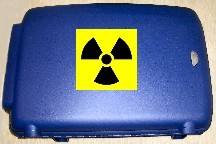
The Dirty Bomb Attack (and what to do)
What is this bomb?
A dirty bomb is a mixture of conventional explosives, such as black powder, dynamite or TNT, with something that is toxic to humans. When the dynamite or other explosives are set off, the blast spreads the toxic substance into the air or atmosphere of the surrounding area.
This is one way to spread nerve gas, anthrax powder, or other toxins to crowded together human beings.
http://www.bt.cdc.gov/radiation/dirtybombs.aspWhat is a RDD?
RDD stands for Radiological Dispersion Device. This is a dirty bomb that uses the explosion of dynamite or other explosives to scatter radioactive dust, smoke, and other material into that local atmosphere. This bomb is small enough to be carried in a suitcase but is NOT considered to be a WMD (a weapon of mass destruction). A dirty bomb works completely differently and cannot create an atomic blast. Why? Because an atomic bomb, like those bombs dropped on Hiroshima and Nagasaki, involves the splitting of atoms and a huge release of energy that produces the atomic mushroom cloud. An RDD doesn't.
How dangerous is a RDD?
This bomb releases radioactive material into the air or atmosphere. In this respect it can be similar to what an atomic bomb explosion does, except on a much smaller scale. The goal is to destroy large numbers of people by the use of radiation sickness. The goal is also to cause wide spread panic and fear among a country's population as well as to adversely affect a country's economy and political structure.
As in the case with an atomic bomb most of the radiation is given off locally and quickly- therefore, the first few hours after an attack are the most dangerous period. The particles themselves look like grains of salt or sand, but stay away from these as the rays are invisible. Don't let your children play outside in this stuff. Areas close to this explosion might receive fallout quickly.
The wind will disperse the radioactive materials through the air currents. But since the amount of radiation is less this means that only local areas will become contaminated and you will need to plan for this if you are in the vicinity of the explosion. You will need to find shelter and stay away from the bombed area until it is deemed safe to go there. If you were near the explosion or down wind of the explosion then you may need to travel a few miles in a horizontal (side ways) direction (from the major direction of the wind) in order to escape from this area. If you stay in this area or zone then you will need to take appropriate shelter from the radiation for a 14 day period of time. If you stay and you do not take appropriate shelter then you may get radiation sickness. A smaller amount of radiation will have been used than in an atomic bomb so the fallout will be less and the fallout distance will be shorter than 320 miles in most instances. Your government authorities will give emergency evacuation orders to those who live down wind of the explosion once the amount of radiation from the explosion is determined.
Any terrorist wants to use terror as a weapon. People are naturally afraid of what they don't understand. Radiation sickness is not understood by most people in the world. The economic costs and social disruption of a nation, not counting the evacuation of large numbers of people and subsequent clean-up of contaminated property, would play into a terrorist's agenda. There are public fears of all things nuclear and radioactive. Fear, panic and chaos are a terrorist's primary objective.

Let your guard down
and
you might get swallowed upHowever, the terrorists have another goal in mind, as well. During America's cold war with the former Soviet Union, the U.S.S.R. held to this theory: "We will force the United States to spend itself into destruction." Global terrorists have the same goal in mind today.
What is the killing distance of radiation?
This answer depends on the amount of radiation given off by the explosion. Some bombs are weaker than others, some only partially explode, and some are duds that don't explode at all.
A general rule of thumb is that any nuclear bomb radiation can be terminal for many people if they are within the 30 mile blast area from the detonation site of the bomb and not in a fallout shelter. Neutrons and gamma rays are the dangerous particles of energy in this wave.
A lethal dose of radiation from the immediate blast will have these effects- varying degrees of shock, possibly within a few hours; nausea, vomiting and diarrhea in the following day or two; then fever. Often there will be no pain in the first few days, but merely discomfort, depression and fatigue.
The early stages of radiation sickness may be followed by two or three days when the patient is free from all symptoms, although profound changes are taking place meanwhile in his body. Then the earlier symptoms reappear. Active illness is soon followed by delirium, coma and finally death, which comes within two to three weeks. Infection, internal bleeding, swelling of the throat glands, loss of hair and degeneration of the sex organs are all apt to occur.
As mentioned above, dangerous fallout can occur down wind as far as 320 miles or so.
How much dirt should be over my shelter to protect me from fallout radiation?
A 3 foot thickness of earth (1 meter or one yard) or a 2 foot thickness of concrete must be the roof of your shelter to protect you from the fallout radiation. The building of underground houses is not presently popular but this will change after a few nuclear bombs are exchanged in the next few nuclear wars on planet earth.
We do not have a basement or fallout shelter at our house. Where can we take cover if we are in the fallout area for two weeks?
A railroad tunnel is a good location that goes into a large hill or mountain. This will give you pretty good protection for two weeks. An underground mine is good if it is safe. A large cement, multi-tiered, car parking building is good as long as you are not on the very top of it. Many cities have subways, fallout shelters, or mass transit tubes that could be used. And there are many other places to take shelter that are not listed here. I suggest that you contact your nearest government Civil Defense Agency for helpful info in your area.
What kind of food do we need in such an emergency?
Soup and sandwiches are the easiest to prepare. There will not be any electricity so you won't have any refrigeration so you can make your sandwiches out of peanut butter, jelly, canned corn beef, canned tuna, etc. Make sure that you take plenty of bread and crackers to your shelter with you as well as your canned goods. Two weeks may seem like an eternity to some folks in a situation like this. Take along plenty of extra for those folks who will join you who don't have any. Use common sense and wisdom in all you do. Show love and kindness to others.
What kind of outside water can we drink in such an emergency?
Radioactive particles will sink to the bottom of an outside water source. If there is a lake, a pond, a river, a swimming pool, or a cistern near your shelter then drink the surface water from it. Don't drink the water from the bottom that contains the radioactive particles.

Jesus weeps over man's inhumanity to man. Nuclear war is not His will.


www.7-star-admiral.com


Click on the above banner if you want to learn how to have a relationship with Jesus Christ.
(doctrine of mainline Christianity)since August 28, 2006